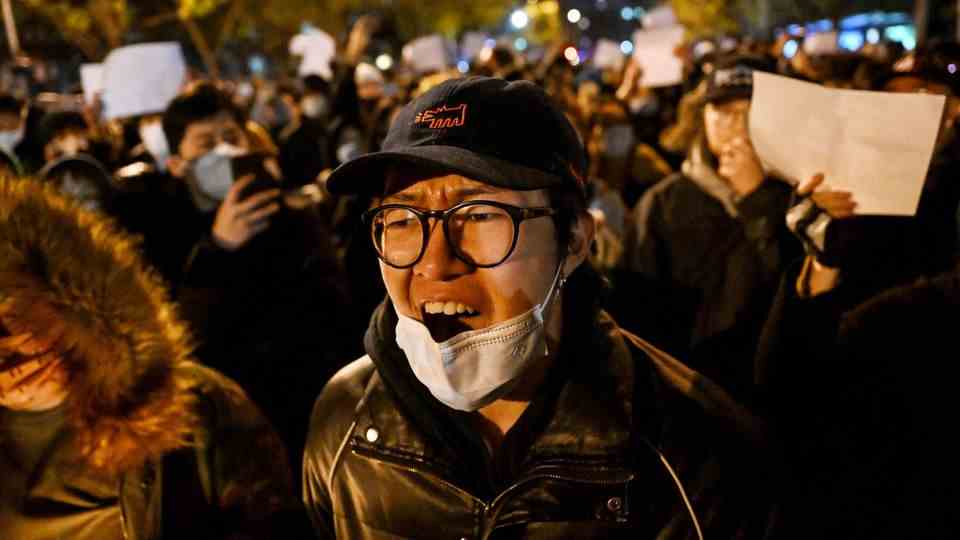Anyone in China who criticizes the regime faces imprisonment and worse. In order to express their frustration with the zero-Covid measures, people in the current protests therefore have to be particularly creative.
Necessity is the mother of invention, they say. A look at the current protests against the strict zero-Covid measures in China shows the truth of the saying. In a country where the government thinks little of free speech, let alone criticism, people are forced to resort to more subtle methods. Pictures from Shanghai show women and men holding up white papers at a vigil in silent protest against censorship. In Beijing, students demonstrated with an equation painted on them that symbolizes the words “free man”.
A high-rise fire in Urumqi in the Xinjiang region, in which several people died, had simmered for months in the Chinese population overflowing. Many suspect that the strict corona measures have hindered the rescue of the residents. Out of frustration and anger about the curfews, forced quarantine, mass tests and the constant control with Covid apps, people in various cities have been taking to the streets for almost a week – the protests reached their peak at the weekend.
These are the largest demonstrations in the People’s Republic since 1989. And it is the creative and often ironic messages that make the protests that have flared up so special.
Against China’s zero-Covid policy with creativity and irony
The hashtag #A4Revolution has been trending on Twitter since the weekend. “A4” refers to the symbol that has already become the most well-known of the protests: a blank, white piece of paper in DIN A4 format. It stands for censorship, for the “feeling of not having a voice, but still being powerful in the crowd”, as participants in the demonstrations of the “New York Times” report. In Shanghai, Beijing and in the Hong Kong Special Administrative Region, people carry the white leaves in front of them like protective shields. Many also use them to commemorate the victims of the fire in Urumqi, because white is a typical color at funerals in China.

People protest in Beijing against the government’s strict corona measures
© Noel Celis / AFP
Some even dare to write texts and symbols on their leaves. In Beijing, students at the elite Tsinghua University held up signs emblazoned with Russian physicist Alexander Friedman’s equation – describing the expansion of the universe – and his last name, like the words “free(d) man”. sound. A demonstrator showed an exclamation point on a red background: the sign used on the WeChat social platform when a message cannot be delivered.
Others are brave enough to speak out. “Unlock the lockdown” and “We don’t want PCR tests, we want freedom,” chanted the demonstrators in Beijing. When the police ordered the crowd to stop, instead they sarcastically demanded “More lockdowns!” and “I want to do Covid tests”.
In the state-regulated social networks, where any criticism of the government is immediately deleted and punished, younger Chinese in particular are finding new ways to express their displeasure. True to the motto “false positive”, they flood the Internet with posts full of Chinese characters for “yes”, “good” and “right” in order to ironically evade censorship.
Lost places in China
Where world-class attractions rot
Even alpacas become a protest symbol
The creative and, for China, unusually broad protest not only reveals displeasure with the restrictions that have been in place for almost three years, but also deep dissatisfaction with the political system. “People are at boiling point because there is no clear way to end the zero-Covid policy,” Alfred Wu Muluan, an expert on Chinese politics at the National University of Singapore (NUS), told AFP news agency. “People feel compelled to take matters into their own hands,” said Yasheng Huang of the Massachusetts Institute of Technology on Twitter.
A scene that caused a stir in Chinese social networks, was the image of a woman leading three alpacas on a leash across “Urumqi Road” in Shanghai. Jeremy Goldkorn, editor-in-chief of the independent media The China Project, shared the image on Twitter with the caption “The grass mud horse lives!” You have to know: “Cǎonímǎ”, the Chinese word for “grass mud horse” – a kind of alpaca – is basically used as an insult and translated means “F*** your mother”.
When the Chinese government began tightening Internet regulation in 2009, people posted pictures of alpacas, or “mud grass horses,” on the Baidu platform to express their frustration with the censorship.
Government responds with increased police presence
It is still unclear how the protests will develop and what consequences they might have for the zero-Covid policy. What should particularly frighten the Chinese party leadership is the population’s anger at the leadership. “Xi Jinping, resign! Down with the Communist Party,” chanted some of the demonstrators in Shanghai, directly attacking the head of state and party. This brings back memories of the pro-democracy mass demonstrations in 1989, which were brutally suppressed by the military.
But the government doesn’t want to let it get that far.
On Monday evening, a large police force prevented further demonstrations in several large cities, and online censorship was tightened. Crowds of security forces were on the streets in Beijing and in major cities such as Shanghai, Guangzhou and Hangzhou. In many cases, passers-by were stopped, had to identify themselves and show their mobile phones, which were checked for suspicious content or programs such as tunnel services (VPN) to circumvent Chinese censorship.
For many Chinese, this means being even more careful in the future and better concealing their messages. At the same time, the creative and often subtle forms of protest present the police with the difficulty of deciding on a case-by-case basis which actions cross the line.
“What should we be afraid of?” a man asks passers-by on the street in Shanghai, who are filming the scene on their cellphones. Above his head he holds a single flower.
Sources: “BBC“, “Guardians“, “NYTimes“, with Twitter and AFP footage

